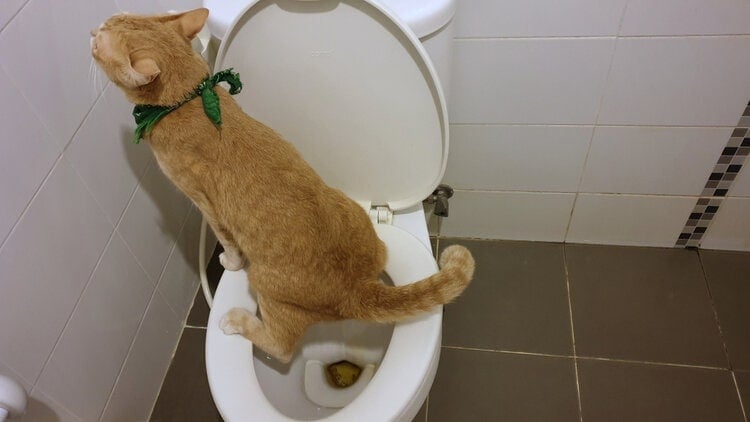Prevent Clogs and Damage: Never Flush Cat Poop Down Your Toilet - Expert Recommendations
Prevent Clogs and Damage: Never Flush Cat Poop Down Your Toilet - Expert Recommendations
Blog Article
What are your thoughts regarding How to Dispose of Cat Poop and Litter Without Plastic Bags?

Intro
As cat owners, it's essential to be mindful of how we take care of our feline buddies' waste. While it may appear hassle-free to purge pet cat poop down the toilet, this practice can have harmful effects for both the setting and human wellness.
Alternatives to Flushing
Fortunately, there are more secure and a lot more liable methods to dispose of cat poop. Take into consideration the complying with alternatives:
1. Scoop and Dispose in Trash
One of the most common approach of taking care of pet cat poop is to scoop it into an eco-friendly bag and throw it in the garbage. Make certain to make use of a specialized clutter scoop and throw away the waste promptly.
2. Use Biodegradable Litter
Choose naturally degradable feline clutter made from products such as corn or wheat. These clutters are eco-friendly and can be securely disposed of in the trash.
3. Hide in the Yard
If you have a lawn, think about hiding pet cat waste in a marked area far from vegetable yards and water sources. Be sure to dig deep sufficient to prevent contamination of groundwater.
4. Mount a Pet Waste Disposal System
Invest in an animal waste disposal system especially designed for feline waste. These systems make use of enzymes to break down the waste, minimizing smell and environmental impact.
Wellness Risks
Along with environmental worries, purging cat waste can also position health and wellness risks to human beings. Feline feces might have Toxoplasma gondii, a bloodsucker that can create toxoplasmosis-- a possibly serious health problem, especially for expecting ladies and people with damaged body immune systems.
Ecological Impact
Flushing cat poop introduces hazardous pathogens and parasites right into the supply of water, presenting a substantial risk to aquatic environments. These contaminants can negatively affect marine life and compromise water high quality.
Conclusion
Accountable family pet ownership extends past supplying food and shelter-- it likewise involves proper waste administration. By refraining from purging pet cat poop down the toilet and selecting different disposal techniques, we can lessen our ecological impact and safeguard human health and wellness.
Why Can’t I Flush Cat Poop?
It Spreads a Parasite
Cats are frequently infected with a parasite called toxoplasma gondii. The parasite causes an infection called toxoplasmosis. It is usually harmless to cats. The parasite only uses cat poop as a host for its eggs. Otherwise, the cat’s immune system usually keeps the infection at low enough levels to maintain its own health. But it does not stop the develop of eggs. These eggs are tiny and surprisingly tough. They may survive for a year before they begin to grow. But that’s the problem.
Our wastewater system is not designed to deal with toxoplasmosis eggs. Instead, most eggs will flush from your toilet into sewers and wastewater management plants. After the sewage is treated for many other harmful things in it, it is typically released into local rivers, lakes, or oceans. Here, the toxoplasmosis eggs can find new hosts, including starfish, crabs, otters, and many other wildlife. For many, this is a significant risk to their health. Toxoplasmosis can also end up infecting water sources that are important for agriculture, which means our deer, pigs, and sheep can get infected too.
Is There Risk to Humans?
There can be a risk to human life from flushing cat poop down the toilet. If you do so, the parasites from your cat’s poop can end up in shellfish, game animals, or livestock. If this meat is then served raw or undercooked, the people who eat it can get sick.
In fact, according to the CDC, 40 million people in the United States are infected with toxoplasma gondii. They get it from exposure to infected seafood, or from some kind of cat poop contamination, like drinking from a stream that is contaminated or touching anything that has come into contact with cat poop. That includes just cleaning a cat litter box.
Most people who get infected with these parasites will not develop any symptoms. However, for pregnant women or for those with compromised immune systems, the parasite can cause severe health problems.
How to Handle Cat Poop
The best way to handle cat poop is actually to clean the box more often. The eggs that the parasite sheds will not become active until one to five days after the cat poops. That means that if you clean daily, you’re much less likely to come into direct contact with infectious eggs.
That said, always dispose of cat poop in the garbage and not down the toilet. Wash your hands before and after you clean the litter box, and bring the bag of poop right outside to your garbage bins.
https://trenchlesssolutionsusa.com/why-cant-i-flush-cat-poop/

As a passionate person who reads on How to Dispose of Cat Poop and Litter Without Plastic Bags, I imagined sharing that short article was really useful. Sharing is nice. You just don't know, you might be helping someone out. I love reading our article about How to Dispose of Cat Poop and Litter Without Plastic Bags.
Schedule A Free Estimate Report this page